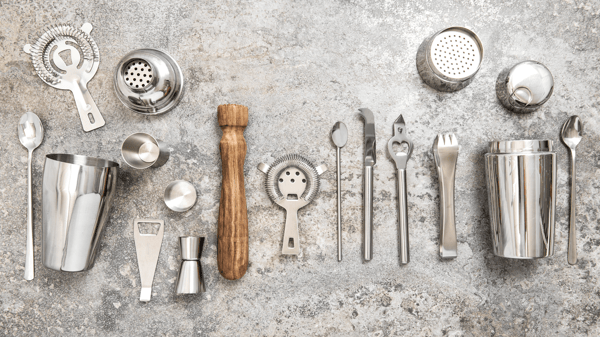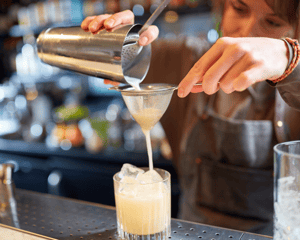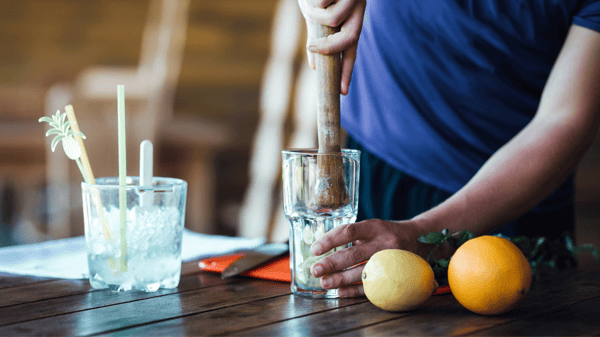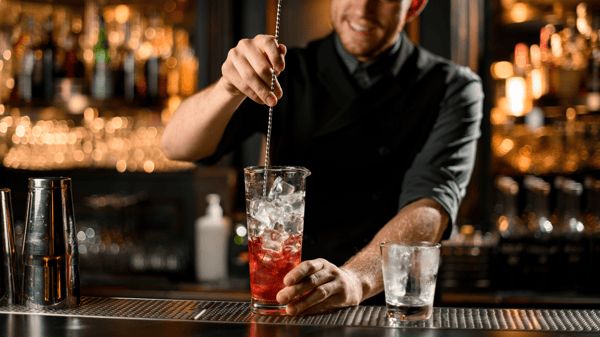Whether you're a novice bartender, or a seasoned pro looking for a quick refresher, this cocktail equipment guide is helpful for anyone that makes drinks behind the bar.
A great bartender is nothing without these tools—enhancing your understanding of bar equipment is just as important as learning new cocktail recipes, or staying sharp with your wine knowledge.
We'll cover all the essential bar tools you need, the pros and cons of each, and how to use them effectively.
Cocktail shakers
There are 3 traditional cocktail shakers that you'll see behind the bar—the Boston shaker, the Cobbler, or the French shaker. Each one poses their own benefits and drawbacks.

The Boston Shaker
This shaker is arguably the most common version you'll see behind the bar. It's a two piece set that consists of one stainless steel tin, and a glass tumbler that fits snugly inside. There are also tin-on-tin varieties.
To strain a drink from this tin, you'll need a separate strainer, such as the Hawthorne. If you're in a pinch, some bartenders like to separate the tin and glass slightly after shaking, and pour the contents straight into the glass. Take care to avoid any ice slipping through!
Pros
The clear glass allows bartenders to see what they're doing as they measure out the cocktail, which can be helpful if you want to avoid overpouring or mistakes.
The glass and the stainless steel are also fairly easy to separate, and don't seal together the way tin on tin does.
Cons
Since you have to seal the tins together, it poses the potential for leaking mid-shake. Make sure you tap it in firmly before you get started, otherwise you might end up with a wet shirt (we've been there).
Additionally, the glass tumbler can potentially break, which is always a hazard bartenders need to be aware of behind the bar.
Pro tip: Take extra care with this shaker—if the tin and the glass are stuck together, never smack them against the bar. A firm tap with the back of your wrist on the lip of the tin should release it from the glass.
The Cobbler Shaker
The Cobbler shaker is a 3-piece set, consisting of one metal tin, a strainer, and a small cap. Everything fits together perfectly, so this compact little piece is easy to shake. It's not as commonly used as the Boston shaker, but it's still a great tool to have behind the bar.
Pros
Rather than having to reach for a separate jigger or strainer, those elements are already built in. The cap can measure out 1 oz pours, and the strainer on top makes it a cinch to pour your cocktails straight from the tin.
The cap and the lid seal tightly, so you're unlikely to end up with a wet shirt from this one!
Cons
Since this shaker is entirely metal, this one can be difficult for new bartenders. As it chills, the metal begins to contract, and the three parts become incredibly difficult to separate after shaking.
Additionally, the built-in strainer has fairly large holes, so this is not ideal for drinks that need to be strained through a finer mesh—you may end up with some ice in your cocktail.
Pro tip: Since the cobbler shaker is metal, you may gently tap it against the bar to loosen the cap if it gets stuck. This should make it easier to twist off, but never whack or slam the tin against a hard surface.
The French Shaker
The French shaker is a two piece set, much like the Boston shaker. However, it's comprised of two stainless steel tins, rather than one glass and one metal. In looks, it somewhat resembles a cross between a Cobbler and a Boston shaker.
This shaker isn't commonly found behind the bar these days, but it's a classic and attractive option.
Pros
It's sleek, it's attractive, and it's compact. This one is eye catching behind the bar, and may be slightly easier to use for a new bartender than a Cobbler shaker.
Cons
The tin on tin creates a bit of a vacuum effect with the chill of the ice, so these metal tins can be quite difficult to separate after shaking.
With this shaker, you can either use a firm whack with the back of your wrist to separate the tins, or a very gentle tap against the bar to break the seal.
Cocktail strainers
While some cocktails are built directly in the glass, most of the time you will have to strain your cocktail before serving it. All of that crushed ice, pulp, and debris should not end up in your cocktail, and the strainer is what keeps your drinks looking clear, attractive, and ready to drink.
Hawthorne

The Hawthorne strainer is the most commonly used strainer, and fits snugly on a variety of different tins/glasses.
The characteristic metal coil traps pulp and ice, preventing it from clouding up that delicious cocktail you just made.
You can use the Hawthorne with a Boston shaker or French shaker, and it fits over many bar glasses too.
This strainer can be a bit of a pain to clean, but the coil can be removed and set back in place if you need to rinse it thoroughly.
Julep
While the Hawthorne strainer fits directly over the tin or glass, the Julep strainer sits just inside the mixing glass at an angle. This strainer does not work as quickly as the Hawthorne.
The Julep is named for its association with the classic Mint Julep cocktail—apparently, folks used this strainer so they could get to every last drop of their cocktail, without having the crushed ice end up on their lap.
The Julep is a classic strainer that has been around for well over a hundred years, so its a testament to this strainers durability and practicality behind the bar.
Its simple design allows for much easier cleaning and maintenance than the Hawthorne.
Fine Mesh
T he fine mesh strainer will help you out where the other two strainers cannot.
he fine mesh strainer will help you out where the other two strainers cannot.
If you're working on a craft cocktail or a Martini, and you really want to ensure that there's no ice, pulp, or particles that make their way into the finished product, then you'll use this fine mesh strainer to finish it off.
It's called a "double strain"—use the Hawthorne or the Julep with your mixing tin, and then place the fine mesh strainer directly over your cocktail glass. You'll end up with a perfectly smooth cocktail every time.
Use a bar spoon to swirl inside the mesh, and ensure you get every last drop into the glass!
The fine mesh strainer isn't necessary to use every time you make a cocktail, but it's important to use if your aim is to make a perfectly smooth cocktail that is free of any additional debris.
Muddlers
Fresh ingredients can really take your cocktails up a notch, and that's where the beauty of muddling comes in.
Muddling is a method for crushing up herbs, fruit, and sugar to release flavors into a cocktail. If you need a perfect example, look no further than the Mojito, everyone's favorite summer cocktail.
Without the act of muddling, the Mojito would lack its distinctly fresh and potent flavors—once muddled, the lime, mint, and sugar combine to release pleasant juices and oils into the cocktail.

In order to muddle your ingredients properly, you'll want to use a firm (but gentle) twisting motion—do not pound your muddler up and down, or use excess force to extract juices. This will bruise your herbs, and render your fruit a pulpy mess. The goal is to extract oils and juices gently, not to pulverize your ingredients beyond recognition.
If you muddle your ingredients too much, you can actually make the cocktail taste bitter, rather than pleasantly balanced. Don't overwork your ingredients, and let the muddler do the work for you.
Muddlers are incredibly diverse in looks, as they come in all kinds of shapes, sizes, and materials. They can range anywhere from bamboo to metal, and some even have a "tenderizer" head to aid with the muddling process.
Cocktails that are muddled:
Mojitos, Old Fashioneds, and Mint Juleps.
Cocktail Glasses
Depending on the bar you work in, you'll utilize glassware in different ways. Some bars may serve their up cocktails in a footed rocks glass, while others may opt serve it in a coupe.
There is some leeway with how you can serve and present a drink, but in some cases, the glassware is designed to serve a specific purpose for the cocktail—whether it's to keep it chilled, preserve the carbonation, or allow it to breathe.
For example, champagne actually used to served in a coupe, until folks realized that the wide bowl of the glass allows the carbonation to dissipate rather quickly—that's why you'll see champagne served in a slender flute today.
We'll cover all of the essential bar glasses, and which cocktails they are suited for.
Highball
The highball is a tall tumbler glass that is ideal for cocktails with a high volume of ice and mixer involved.
Cocktails in this glass will be served with a lot of ice, so there's no need for any delicate stemware here. The warmth of your hands will not compromise the integrity of any drinks served in this glass.
This glass is perfect for basic spirit and mixer cocktails, such as gin and tonics. You'll also use this glass to serve Palomas and Mojitos.
Collins
The collins is the taller, narrower cousin of the highball, and these two glasses are often used interchangeably.
Much like the highball, this glass has high walls so as to contain the high ratio of mixer involved. Its name is derived from the collins family of cocktails.
Old Fashioned or Rocks
These glasses are short, stout, and have a very thick base. Drinks served in this glass will be spirit forward, and have little to no mixer involved--hence why you can get away with a much shorter glass.
As you can guess, many classic cocktails will be served in this glass--sazeracs, negronis, and old fashioneds. But you can also serve a margarita or a whiskey sour in this glass if your guest requests the drink on the rocks.
The thick glass and short frame keeps your drinks cool and well insulated, so this glass is versatile and perfect for
Footed Rocks
This attractive little glass is great for serving your signature cocktails. This glass should be reserved for cocktails without ice, so cocktails that are shaken or stirred can be served in this glass.
You can serve a whiskey sour or manhattan in this glass if your guest would like it served up. The thick little foot at the bottom helps keep the drink chilled, as your guest can use it to reach for their cocktail.
Coupe
The coupe is the perfect vessel for any craft cocktail. This attractive glass has a delicate stem and a wide bowl, perfect for sipping.
Much like a footed rocks glass, this glass is used for up cocktails that are shaken or stirred. The long stem prevents the glass from heating up, and keeps the cocktail perfectly chilled.
If you want to instantly elevate a cocktail, we recommend using this glass. A gimlet, a last word, or a daiquiri looks great in this glass.
Martini
As you can surmise, this glass is generally reserved for your classic Martini. Much like a coupe, the martini glass has a delicate stem that keeps the cocktail chilled and away from the warmth of your hands.
Margarita
The Margarita glass is reserved for up Margaritas. Not every bar will us this glass, as a footed rocks or a coupe can also work for this cocktail.
The Margarita glass isn't as versatile as other cocktail glasses, and some bars favor using the coupe instead.
Snifter
This glass is used for swirling aged spirits, like brandy or whiskey. The wide bowl allows for the aromas of the spirit to be released, while the narrow opening keeps the scent from dissipating.
Cordial
This glass is typically used in higher end bars and restaurants. It has a small, slender flute that somewhat resembles a champagne glass. It's used to serve liqueurs and cordials after a meal.
Cocktail Mixing Glasses
 Cocktail mixing glasses are a vessel for stirring cocktails—Manhattans, Sazeracs, and Martinis, among others.
Cocktail mixing glasses are a vessel for stirring cocktails—Manhattans, Sazeracs, and Martinis, among others.
Mixing glasses allow you to control the dilution and clarity of a cocktail, and it's ideal for drinks that supposed to have a smooth texture.
The two most common varieties you'll see are the pint glass and the Yarai glass.
Pint glass
A pint glass is always readily available at any bar, so you're likely to have used one of these to stir a cocktail at some point. While the standard pint glass isn't anything to write home about, this stirring vessel gets the job done, and it's easy to use.
Yarai mixing glass
You'll probably spot this Japanese mixing glass at craft cocktail bars, as its elegant hatched design is quite attractive, and instantly elevates any bar top.
This glassware somewhat resembles a beaker. There is a small spout that makes it easy to pour your cocktails, and you can use a Hawthorne or a Julep strainer with these.
The benefit of this glass is that it's the same width the entire way around, unlike the pint glass, which is tapered. It allows for bartenders to execute a much smoother stirring motion.
Spoons
A bar spoon looks a little different than your standard flatware spoon—it typically has a very long handle so it can reach the bottom of tumblers and mixing glasses, and the twisted stem allows for bartenders to stir with ease.
While you may think a bar spoon only has one use, it's an incredibly versatile bar tool. Bar spoons can be used for stirring, swizzling, floating, muddling and measuring. That's quite a lot for one piece of equipment.

While all bar spoons have their similarities, there are some subtle differences that come into play.
American
This standard spoon has a simple design, and is one of the most common bar spoons on the market. It's easy to spot, as it has a red cap at the end of the stem.
European
Unlike the American, this spoon has a flat disc at the end of its stem, which can be used for crushing small amounts of fruit if you don't have a muddler nearby. The flat disc also comes in handy for layering your drinks.
Japanese
Arguably, this bar spoon is the most elegant looking of the three. It's longer, thinner, and the weighted teardrop at the end of the stem allows bartenders to stir more effectively.


